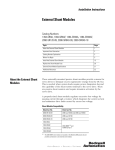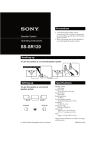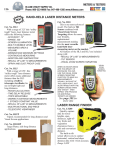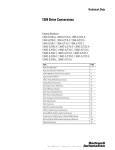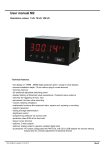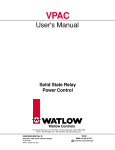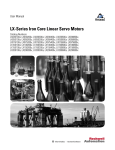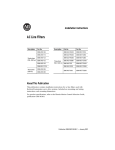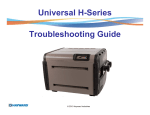Download 2090-IN004 - Rockwell Automation
Transcript
Installation Instructions External Shunt Modules Catalog Numbers 1394-SR9A, 1394-SR9AF, 1394-SR36A, 1394-SR36AF, 2090-SR120-09, 2090-SR040-09, 2090-SR040-18 Topic Page About the External Shunt Modules 1 Important User Information 2 Catalog Number Explanation 3 Before You Begin 3 Mounting Requirements 4 Install the External Shunt Module 7 Replace the Shunt Module Fuse 14 External Shunt Module Specifications 15 Additional Resources 16 About the External Shunt Modules These externally-mounted passive shunt modules provide a means for servo drives to dissipate excess regenerative energy from the DC bus. This is needed when system loads require power dissipation beyond the capability of the shunt resistor internal to the servo drive. These are passive shunt resistors and require transistor activation by the servo drive. A properly-sized shunt module regulates excessive bus voltage by passing current through a resistor that dissipates the current as heat and minimizes drive faults. 2 External Shunt Modules Important User Information Read this document and the documents listed in the additional resources section about installation, configuration, and operation of this equipment before you install, configure, operate, or maintain this product. Users are required to familiarize themselves with installation and wiring instructions in addition to requirements of all applicable codes, laws, and standards. Activities including installation, adjustments, putting into service, use, assembly, disassembly, and maintenance are required to be carried out by suitably trained personnel in accordance with applicable code of practice. If this equipment is used in a manner not specified by the manufacturer, the protection provided by the equipment may be impaired. In no event will Rockwell Automation, Inc. be responsible or liable for indirect or consequential damages resulting from the use or application of this equipment. The examples and diagrams in this manual are included solely for illustrative purposes. Because of the many variables and requirements associated with any particular installation, Rockwell Automation, Inc. cannot assume responsibility or liability for actual use based on the examples and diagrams. No patent liability is assumed by Rockwell Automation, Inc. with respect to use of information, circuits, equipment, or software described in this manual. Reproduction of the contents of this manual, in whole or in part, without written permission of Rockwell Automation, Inc., is prohibited. Throughout this manual, when necessary, we use notes to make you aware of safety considerations. WARNING: Identifies information about practices or circumstances that can cause an explosion in a hazardous environment, which may lead to personal injury or death, property damage, or economic loss. ATTENTION: Identifies information about practices or circumstances that can lead to personal injury or death, property damage, or economic loss. Attentions help you identify a hazard, avoid a hazard, and recognize the consequence. IMPORTANT Identifies information that is critical for successful application and understanding of the product. Labels may also be on or inside the equipment to provide specific precautions. SHOCK HAZARD: Labels may be on or inside the equipment, for example, a drive or motor, to alert people that dangerous voltage may be present. BURN HAZARD: Labels may be on or inside the equipment, for example, a drive or motor, to alert people that surfaces may reach dangerous temperatures. ARC FLASH HAZARD: Labels may be on or inside the equipment, for example, a motor control center, to alert people to potential Arc Flash. Arc Flash will cause severe injury or death. Wear proper Personal Protective Equipment (PPE). Follow ALL Regulatory requirements for safe work practices and for Personal Protective Equipment (PPE). Rockwell Automation Publication 2090-IN004C-EN-P - May 2014 External Shunt Modules 3 Catalog Number Explanation Catalog numbers consist of various characters, each of which identifies a specific version or option for that component. Use the catalog numbering charts below to understand the configuration of your shunt module. Table 1 - Bulletin 1394 External Shunt Modules 1394 - SR xxxx kW Rating 9A = 300 W continuous, 4 Ω, no fan 9AF = 900 W continuous, 4 Ω, no fan 36A = 1800 W continuous, 4 Ω, no fan 36AF = 3600 W continuous, 4 Ω, fan-cooled, thermal switch SR = Shunt Resistor Bulletin Number Table 2 - Bulletin 2090 External Shunt Modules 2090 - SR xxx - xx Continuous Power Rating 09 = 900 W continuous, no fan 18 = 1800 W continuous, no fan Resistance Rating 120 = 120 Ω 040 = 40 Ω SR = Shunt Resistor Bulletin Number Before You Begin Before mounting your shunt module, make sure you do the following: • • • • Have the required tools and materials Understand the mounting requirements Understand high-frequency bonding Know how to establish noise zones For more information on high-frequency bonding and routing of cables within established noise zones, refer to the System Design for Control of Electrical Noise Reference Manual, publication GMC-RM001. For the user manual with information specific to your servo drive family, refer to Additional Resources on page 16. Rockwell Automation Publication 2090-IN004C-EN-P - May 2014 4 External Shunt Modules Required Tools and Materials These tools and materials are required to complete the installation of an external shunt module: • Screwdrivers • User-supplied power wiring • Mounting fasteners Mounting Requirements ATTENTION: Plan the installation of your system so that you can perform all cutting, drilling, tapping, and welding with the system removed from the enclosure. Because the system is of the open type construction, be careful to keep any metal debris from falling into it. Metal debris or other foreign matter can become lodged in the circuitry and result in damage to components. These requirements apply when preparing to mount your shunt module: • Mount the shunt in an enclosure providing protection against dust and splashing water (IP54), or dust free and protected against water jets (IP65). Many NEMA (National Electrical Manufacturers Association) Type 4 cabinets provide this level of protection. • Install the panel for mounting your system components inside the enclosure on a flat, rigid, vertical surface that won’t be subjected to shock, vibration, moisture, oil mist, dust, or corrosive vapors. Refer to Environmental Specifications on page 15 for specific recommendations. • Maintain minimum clearances for proper airflow, easy module access, and proper bend radius for the cables as shown in the figures beginning on page 5. • Use high-frequency (HF) bonding techniques to connect the module, enclosure, machine frame, and motor housing, and to provide a low-impedance return path for high-frequency (HF) energy and reduce electrical noise. Refer to HF Bonding Your Shunt Module, on page 6, for more information. • Segregate DC-bus wiring from control wiring and motor feedback cables. Do not run shunt wiring in wireways. Use twisted pair cable from the drive to external shunt module. Refer to Cable Noise Zone Categories, beginning on page 6, for specific recommendations. IMPORTANT Mount the shunt module in an upright position. Do not mount the shunt module on its side. Rockwell Automation Publication 2090-IN004C-EN-P - May 2014 External Shunt Modules 5 Figure 1 - Minimum Clearance Requirements (within an enclosure) 150 mm (6.0 in.) clearance for airflow and installation. 150 mm (6.0 in.) clearance for airflow and installation. Shunt Module ALLEN-BRADLEY 150 mm (6.0 in.) clearance for airflow and installation. BULLETIN 1394 300W SHUNT MODULE CAT. PART SER. INPUT DC INPUT AC FOR FUSE REPLACEMENT USE: BUSSMAN CAT. NO. FOR USE WITH 1394-SJT22-X SYSTEM MODULE Enclosure 150 mm (6.0 in.) clearance for airflow and installation. Bulletin 1394 and 2090 External Shunt Modules (1394-SR9Ax module is shown in this example.) BURN HAZARD: The shunt resistors can reach temperatures in excess of 350 °C (662 °F). Do not handle a shunt module that has been operational until it has cooled sufficiently. Shield combustible materials above the shunt module or its enclosure with a metal plate to protect them from the heat. Failure to observe these precautions could result in damage to surrounding materials, possibly leading to a fire or personal injury. ATTENTION: The shunt resistors release large amounts of heat. When mounted inside an enclosure, you must provide adequate ventilation so the maximum ambient temperature of 50 °C (122 °F) is not exceeded. Failure to observe this precaution could result in damage to the module. Rockwell Automation Publication 2090-IN004C-EN-P - May 2014 6 External Shunt Modules Figure 2 - Minimum Clearance Requirements (outside the enclosure) 254 mm (10.0 in.) clearance for airflow and installation. 1394 Digital Servo Controller 3600W Shunt Module 150 mm (6.0 in.) clearance for airflow and installation. 150 mm (6.0 in.) clearance for airflow and installation. ALLEN-BRADLEY BULLETIN 1394 3600W SHUNT MODULE CAT. PART SER. INPUT DC INPUT AC FOR FUSE REPLACEMENT USE: BUSSMAN CAT. NO. FOR USE WITH 1394-SJT22-X SYSTEM MODULE Bulletin 1394 and 2090 External Shunt Modules (1394-SR36Ax module is shown in this example.) 150 mm (6.0 in.) clearance for airflow and installation. HF Bonding Your Shunt Module Bonding is the practice of connecting metal chassis, assemblies, frames, shields, and enclosures to reduce the effects of electromagnetic interference (EMI). For more information on the concept of high-frequency (HF) bonding, the ground plane principle, and electrical noise reduction, refer to System Design for Control of Electrical Noise Reference Manual, publication GMC-RM001. IMPORTANT To improve the bond between the drive system and subpanel, construct your subpanel out of zinc plated (paint-free) steel. Cable Noise Zone Categories This table provides the zoning requirements of cables connecting to the external shunt module. Zone Method Wire/Cable Very Dirty COL, DC+ (shielded option) Dirty Clean Ferrite Sleeve Shielded Cable X X Thermal switch X X Fan (if present) X COL, DC+ (unshielded option) X Rockwell Automation Publication 2090-IN004C-EN-P - May 2014 External Shunt Modules 7 Install the External Shunt Module These procedures assume you have prepared your mounting panel and understand how to bond your system components. Mount the External Shunt Module Follow these steps to mount your external shunt module. 1. Lay out the position for your shunt module. Refer to Product Dimensions, beginning on page 8, for mounting hole locations. IMPORTANT To improve EMC performance, mount the module on the same panel as the drive and as close to the drive as possible. 2. Attach the shunt module to the cabinet by using M6 (0.25 in.) bolts. Make sure all fasteners are properly bonded to the subpanel. 3. Tighten all mounting fasteners. Rockwell Automation Publication 2090-IN004C-EN-P - May 2014 8 External Shunt Modules Product Dimensions Figure 3 - Catalog Numbers 2090-SR120-09, 2090-SR040-09, 1394-SR9A, and 1394-SR9AF 150 (5.9) 8.0 (0.32) Dimensions are in mm (in.) 25.0 (0.98) 100 (3.9) 280 (11.0) 25.0 (0.98) 125 (4.9) 155 (1) (6.1) Shunt Module ALLEN-BRADLEY 175 (6.9) Mounting Hole Detail R 8.0 (0.31) BULLETIN 1394 300W SHUNT MODULE CAT. PART SER. INPUT DC INPUT AC FOR FUSE REPLACEMENT USE: BUSSMAN CAT. NO. FOR USE WITH 1394-SJT22-X SYSTEM MODULE Front View (1) 125 (4.9) Dimension shown is for mounting hardware location and does not reflect the location of the lower slot radius. 15.9 (0.63) 8.0 (0.31) 10.1 (0.40) Side View 12.0 (0.47) All slots accept M6 or 1/4-20 mounting screws. Figure 4 - Catalog Numbers 1394-SR36A, 1394-SR36AF, and 2090-SR040-18 8.0 (0.32) 150 (5.9) 385 (1) (15.2) 350 (13.7) 15.9 (0.63) 8.0 (0.31) ALLEN-BRADLEY R FOR USE WITH 1394-SJT22-X SYSTEM MODULE 10.1 (0.40) 12.0 (0.47) All slots accept M6 or 1/4-20 mounting screws. Front View (1) 400 (15.7) Mounting Hole Detail 8.0 (0.31) BULLETIN 1394 3600W SHUNT MODULE CAT. PART SER. INPUT DC INPUT AC FOR FUSE REPLACEMENT USE: BUSSMAN CAT. NO. 280 (11.0) 24.8 (0.98) 350 (13.7) Shunt Module Dimensions are in mm (in.) 25.0 (0.98) 100 (3.9) Dimension shown is for mounting hardware location and does not reflect the location of the lower slot radius. Rockwell Automation Publication 2090-IN004C-EN-P - May 2014 Side View External Shunt Modules 9 Wire the External Shunt Module This section assumes you have mounted your external shunt module and are ready to wire the shunt module power connections. Refer to Additional Resources on page 16 for the specific user manual with drive-end installation instructions for your servo drive. IMPORTANT The National Electrical Code and local electrical codes take precedence over the values and methods provided. Wire must be copper with 105 °C (221 °F) 600V minimum rating. Table 3 - DC-bus Wiring Requirements External Shunt Cat. No. Shunt Module Terminals Recommended Wire Size mm2 (AWG) Torque Value N•m (lb•in) COL 2090-SRxxx-xx 6 (10) DC+ 1.8 (16) COL 1394-SR9Ax, 1394-SR36Ax 8.4 (8) DC+ Follow these steps to wire your external shunt module. 1. Remove power from your drive system that includes the Bulletin 1394 or 2090 shunt module. ATTENTION: This system can have multiple sources of power and more than one disconnect switch to de-energize the system. To avoid shock hazard or personal injury, verify that all power has been removed before proceeding. ATTENTION: This product contains stored energy devices. To avoid hazard of electrical shock, verify that all voltage on the capacitors has been discharged before attempting to service, repair, or remove this unit. Do not attempt the procedures in this document unless you are qualified to do so and familiar with solid-state control equipment and the safety procedures in publication NFPA 70E. 2. Prepare the shunt DC-bus wires for attachment to the shunt power terminals by removing 10 mm (0.39 in.) of insulation. IMPORTANT Use caution not to nick, cut, or otherwise damage strands as you remove the insulation. Rockwell Automation Publication 2090-IN004C-EN-P - May 2014 10 External Shunt Modules 3. Insert one wire into the shunt power terminal labeled COL. 4. Insert the other wire into the shunt power terminal labeled DC+. 5. Tighten both screw terminals. Refer to torque values in the table on page 9. 6. Gently pull on each wire to make sure it does not come out of its terminal; reinsert and tighten any loose wires. Figure 5 - Shunt Module Terminations 1394-SR36Ax and 2090-SR040-18 External Shunt Modules (2) 1394-SR9Ax, 2090-SR120-09, and 2090-SR040-09 External Shunt Modules (1) Shunt Power Connector Shunt Fan (3) Connector Shunt Power Connector Thermal Switch (3) Terminal Block (1) (2) (3) Shunt module is shown with front cover open. Shunt module is shown with front cover removed. Only the 1394-SR36AF shunt module has the fan and thermal switch connections. Rockwell Automation Publication 2090-IN004C-EN-P - May 2014 External Shunt Modules 11 Wire the Shunt Module Fan This procedure applies to only the 1394-SR36AF shunt module and assumes that you have mounted the module and wired the shunt DC-bus connections. Refer to Additional Resources on page 16 for the specific user manual with drive-end installation instructions for your servo drive. You can wire the shunt fan connections for 115V or 230V AC input power. Wire must be copper with 75 °C (167 °F) minimum rating. Table 4 - Fan Power Specifications Input Power Current 115V AC 0.2 A 230V AC 0.1 A IMPORTANT If you mount the shunt module outside the cabinet, the shunt fan power wiring must be inside metal conduit to minimize the levels of EMI and RFI. Table 5 - Fan Power Wiring Requirements Fan Terminal Connections External Shunt Module Cat. No. 1394-SR36AF Pin Voltage (V AC) 1 115, 230 4 115, 230 1 to 3 (jumper wire) 115 2 to 4 (jumper wire) 115 2 to 3 (jumper wire) 230 Recommended Wire Size mm2 (AWG) Torque Value N•m (lb•in) 1.3 (16) 0.6 (6) Rockwell Automation Publication 2090-IN004C-EN-P - May 2014 12 External Shunt Modules Follow these steps to wire the shunt fan. 1. Verify that all power is removed from the system. 2. Open the front door of the shunt module. 3. Use a screwdriver to remove the plate that covers the fan wire access hole on the bottom right side of the module. Refer to the figure on page 10 for the location of the fan power terminal block. 4. Insert the jumper wires that came with your shunt module to support the input power used in your application. 5. Insert one wire from the AC power supply into terminal 1. Wiring the Fan for 115V To Power Supply 1 To Power Supply Wiring the Fan for 230V To Power Supply 1 2 2 3 3 4 To Power Supply 4 6. Insert the other wire from the AC power supply into terminal 4. 7. Tighten all screw terminals. IMPORTANT When tightening screws to secure the wires, refer to the table page 11 for torque values. 8. Gently pull on each wire to make sure it does not come out of its terminal; reinsert and tighten any loose wires. Rockwell Automation Publication 2090-IN004C-EN-P - May 2014 External Shunt Modules 13 Wire the Thermal Switch This procedure applies to only the 1394-SR36AF shunt module and assumes that you have mounted the module, wired the power connections, and are ready to connect the thermal switch wires. Refer to Additional Resources on page 16 for the specific user manual with drive-end installation instructions for your servo drive. Wire must be copper with 75 °C (167 °F) minimum rating. Table 6 - Thermal Switch Wiring Requirements External Shunt Module Cat. No. Thermal Switch Connections Recommended Wire Size mm2 (AWG) Torque Value N•m (lb•in) 0.75 (18) 0.6 (6) TS1 1394-SR36AF TS2 Follow these steps to wire the thermal-switch terminal block. 1. Verify that all power is removed from the system. 2. Open the front door of the shunt module. 3. Insert one wire into the top terminal of the thermal-switch terminal block. TS1 TS2 4. Insert the other wire into the lower terminal of the thermal-switch terminal block. Refer to the figure on page 10 for the location of the thermal-switch terminal block. 5. Tighten all screw terminals. 6. Gently pull on each wire to make sure it does not come out of its terminal; reinsert and tighten any loose wires. Rockwell Automation Publication 2090-IN004C-EN-P - May 2014 14 External Shunt Modules Replace the Shunt Module Fuse Follow these steps to replace the fuse in your external shunt module. 1. Remove power from your drive system that includes the Bulletin 1394 or 2090 shunt module. ATTENTION: This system can have multiple sources of power and more than one disconnect switch to de-energize the system. To avoid shock hazard or personal injury, verify that all power has been removed before proceeding. ATTENTION: This product contains stored energy devices. To avoid hazard of electrical shock, verify that all voltage on the capacitors has been discharged before attempting to service, repair, or remove this unit. Do not attempt the procedures in this document unless you are qualified to do so and familiar with solid-state control equipment and the safety procedures in publication NFPA 70E. 2. Open the front door panel and locate the fuse holder. 1394-SR9A, 1394-SR9AF, 2090-SR120-09, and 2090-SR040-09 Shunt Modules 1394-SR36A, 1394-SR36AF, and 2090-SR040-18 Shunt Modules Fuse Holder In each case, the fuse holder is in the bottom center of the shunt enclosure, in some cases, behind terminal blocks. 3. Remove the blown fuse from the fuse holder. Use a fuse puller or screwdriver to remove the fuse. 4. Insert the new fuse. Refer to External Shunt Module Specifications on page 15, for the properly rated fuse. 5. Close and secure the door panel. 6. Apply power to your system and verify proper operation. Rockwell Automation Publication 2090-IN004C-EN-P - May 2014 External Shunt Modules 15 External Shunt Module Specifications This section provides specifications for the Bulletin 1394 and Bulletin 2090 external shunt modules. Table 7 - External Shunt Module Specifications Specifications External Shunt Module Cat. No. Drive Voltage V AC Resistance W 200 (1) Peak Power kW Peak Current Amps 41.0 101.25 4 1394-SR9A 400 200 (1) 160.0 200 41.0 101.25 4 1394-SR9AF 400 200 (1) 400 200 (1) 160.0 200 41.0 101.25 400 300 3.63 (8) 160.0 200 41.0 101.25 FWP50A14F FNQ-R-20-R1 (1) 200 3.63 (8) FWP50A14F FNQ-R-20-R1 (1) 8.6 (19) FWP50A14F FNQ-R-25-R1 (1) 3600 160.0 Bussmann Replacement Fuse FNQ-R-20-R1 (1) 1800 4 1394-SR36AF Shipping Weight kg (lbs) 900 4 1394-SR36A Cont. Power Watts 9.0 (20) FWP50A14F 2090-SR120-09 400 120 5.3 6.7 900 3.63 (8.0) FWP-2.5A14F 2090-SR040-09 400 40 16.0 20.0 900 3.63 (8.0) FWP-5A14F 2090-SR040-18 400 40 16.0 20.0 1800 8.6 (19.0) FWP-6.3A14F (1) Requires the use of an FNQ fuse with an adapter to allow the smaller body fuse to fit the larger FWP fuse holder. ATTENTION: The Bulletin 1394 and 2090 shunt modules ship with fuses rated for 460V operation. For operation with drive systems that use 230V input power, you must replace the 460V shunt fuse with a 230V fuse. Failure to observe this precaution could result in equipment damage. Table 8 - Environmental Specifications Attribute Ambient operating temperature Value (1) 0…50 °C (32…122 °F) Vibration 2 g at 10…2000 Hz Shock 15 g 11 ms half sine Altitude 1500 m (5000 ft) Humidity, noncondensing 5…95% (1) Power performance increases about 5.5 W for every 1 °C (3.1 W/°F) drop in ambient temperature. Rockwell Automation Publication 2090-IN004C-EN-P - May 2014 Additional Resources These documents contain additional information concerning related products from Rockwell Automation. Resource System Design for Control of Electrical Noise Reference Manual, publication GMC-RM001 Description Information, examples, and techniques designed to minimize system failures caused by electrical noise. EMC Noise Management DVD, GMC-SP004 Kinetix® 6000 Multi-axis Servo Drive User Manual, publication 2094-UM001 Kinetix 6200 and Kinetix 6500 Modular Servo Drive User Manual, publication 2094-UM002 Mounting, wiring, setup with RSLogix™ 5000 software or the Studio 5000 Logix Designer™ application, power-up, troubleshooting, and application diagrams. Ultra™3000 Digital Servo Drives Installation Manual, publication 2098-IN003 Ultra5000 Intelligent Positioning Drives Installation Manual, publication 2098-IN001 Mounting, wiring, applying power, troubleshooting, and application diagrams. 1394 SERCOS interface Multi-axis Motion Control System Installation Manual, publication 1394-IN002 900 Watt Passive Shunt Installation Instructions, publication 2090-IN001 300 Watt Active Shunt Regulator Installation Instructions, publication 2090-IN002 Mounting and wiring instructions for use with ULTRA 100, ULTRA 200, ULTRA Plus, Ultra3000, and Ultra5000 200V-class drives. 200 Watt Passive Shunt Regulator Installation Instructions, publication 2090-IN003 1394 Digital AC Multi-axis Motion Control System User Manual, publication 1394-5.0 Mounting, wiring, setup with the HIM module, power-up, troubleshooting, and application diagrams. 1394 External Shunt Resistor Kit Installation Instructions, publication 1394-5.6 Mounting and wiring instructions for use with Bulletin 1394 (5 and 10 kW) 400V-class drives. You can view or download publications at http://literature.rockwellautomation.com. To order paper copies of technical documentation, contact your local Allen-Bradley distributor or Rockwell Automation sales representative. Rockwell Automation maintains current product environmental information on its website at http://www.rockwellautomation.com/rockwellautomation/about-us/sustainability-ethics/product-environmental-compliance.page. Allen-Bradley, Kinetix, RSLogix, Rockwell Software, Rockwell Automation, Studio 5000 Logix Designer, and Ultra are trademarks of Rockwell Automation, Inc. Trademarks not belonging to Rockwell Automation are property of their respective companies. Rockwell Otomasyon Ticaret A.Ş., Kar Plaza İş Merkezi E Blok Kat:6 34752 İçerenköy, İstanbul, Tel: +90 (216) 5698400 Publication 2090-IN004C-EN-P - May 2014 Supersedes Publication 2090-IN004B-EN-P - June 2008 PN-256195 Copyright © 2014 Rockwell Automation, Inc. All rights reserved. Printed in the U.S.A.
















